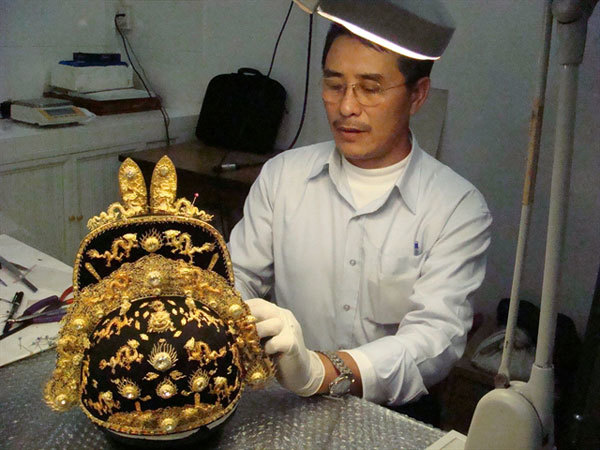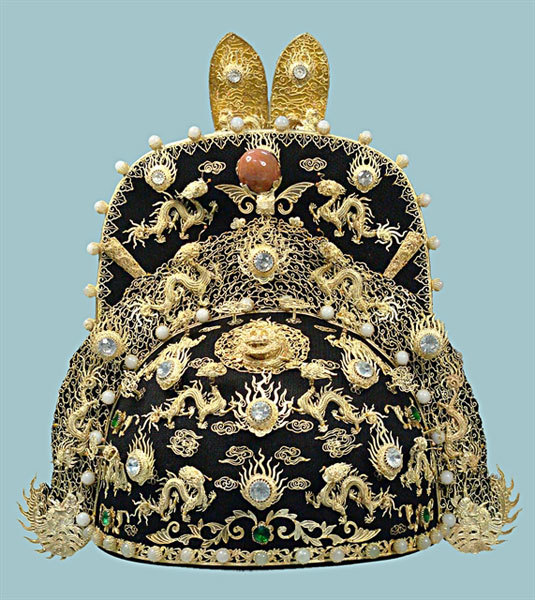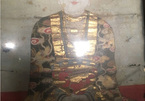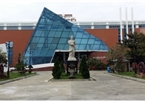 |
| DETAILED PROCESS: Loc restores an emperor’s hat from the Nguyen Dynasty at the Vietnam National Museum of History. Photo courtesy of Vu Kim Loc |
The 63-year-old has successfully restored four emperor hats from the Nguyen Dynasty, in addition to contributing to the restoration of four mandarin hats.
He has also authored many books on Vietnamese history, such as Nghề Kim Hoàn Của Chămpa (Goldsmith of the Champa Kingdom), Cổ Vật Chămpa (Champa Artifacts), and Cổ Vật Huyền Bí (Mysterious Antiques).
Passion for restoration
Loc left his hometown in the northern province of Hung Yen more than 20 years ago to start a new life as a goldsmith, which exposed him to a great deal of ancient jewellery and inspired his passion for collecting antiques.
“I have long been interested in ancient statues, particularly the hat on top,” he recalled. “My travels took me to wherever there were ancient statues. I also read many history books, collected images, and gradually created an archive of materials to satisfy my passion.”
In 2006, one of his friends, who is also an antiques collector, asked him to restore an emperor hat from the Champa Kingdom dating back to the 7th century, or about 1,400 years ago.
“When I first looked at the hat, it was a mess of gold and silver pieces and other details, while its frame had already begun to rot away,” he remembered.
Accepting his friend’s request, he spent days researching and trying his hand at the task. After two months of struggle, the emperor hat was finally restored and was checked and evaluated by specialists, who found it to be more than 90 per cent restored to its original state - an achievement Loc did not expect to obtain.
“This made me even more fascinated and interested in restoring ancient hats of emperors and mandarins,” he said.
 |
| AS IT WAS: An emperor’s hat from the Nguyen Dynasty, restored by artisan Vu Kim Loc, is now on display at the Vietnam National Museum of History. Photo courtesy of Vu Kim Loc |
Emperor hats
One day in mid-2008, Loc received an offer from Dr Pham Quoc Quan, former Director of the Vietnam National Museum of History, to participate in the restoration of four Nguyen Dynasty emperor hats in quite poor condition.
Without even seeing the hats or forming an opinion as to whether restoration was even possible, his curiosity took him to Hanoi to see the treasures with his own eyes.
Loc recalled feeling numb and breaking out in sweat upon seeing the remains of the hats.
They were completely ravaged, and were accompanied by two bags full of gold and jewellery.
“There were about 2,000 discrete details to be restored,” he said. “I was greatly concerned and under pressure, not knowing how to even begin or what the result may be.”
The most crucial task but also the most difficult was finding documents and photos of the hats.
Looking at the specific details, he immediately recognised three of them, but what their shapes were and how to restore them were not at all clear and this occupied Loc’s thoughts for days.
He decided to seek out the soul of the ancient treasures. He travelled to Hue, visiting mausoleums and shrines to take photos and scrutinise statues and paintings of the Nguyen emperors.
He also visited museums and conservation centres seeking resources and a scientific basis before embarking on the restoration.
After collecting sufficient documents and determining what direction to take, Loc undertook the task with support from many experts, including Quan.
“There were many conflicting opinions initially about how to proceed with the restoration,” he recalled. “I was under a great deal of pressure, but fortunately Quan was assertive. He gave me absolute authority to decide on a path forward. I would have lacked the patience to complete the project otherwise.”
The hats were finally finished after more than a year of tireless effort. The result astonished scientists and archaeologists both in Vietnam and abroad, which was a great source of happiness and of pride for Loc.
Few people know that he is also one of the last artisans capable of restoring Mã Vĩ hats, which have fallen into oblivion for nearly 100 years.
According to Loc, 1930s Hanoi had a Mã Vĩ Street that was renowned for making hats for emperors, mandarins, and the aristocracy. But the street disappeared after the last artisans passed away and the younger generation no longer wanted to continue the trade.
Documents on the profession are rare. The only information Loc found simply states that the hats were famous and popular in the past and nothing more.
“It was probably predestined that I would find this field of endeavour,” he believes. “It has become my passion and drives me to explore, research, and learn more to satisfy my curiosity.”
Artisans of days long gone used horse hair as the main material for Mã Vĩ hats, and decorated them with patterns made from gold, silver, and jewellery.
Early on, Loc had to study information and photos from ancient statues and paintings of emperors and mandarins for reference.
As soon as he heard about a family of a former mandarin who had retained an old hat, he would immediately come to ask about buying it to analyse each and every detail.
He has now accumulated enough to create a database of information on Vietnamese royal hats, particularly those belonging to the Nguyen Dynasty.
Few artisans pursue this job nowadays, making it difficult to find proper materials. Horsehair, for example, has to be purchased in northern provinces near the Chinese border.
After securing all the necessary materials, he begins to create a framework to knit the hair around before embroidering and decorating it with patterns.
“It takes me about a year to complete a Mã Vĩ hat,” he revealed. “It demands diligence, meticulousness in every little detail, and, particularly, a spiritual respect for the remains of the item.”
 |
| RELIC: A hat belonging to Thoai Ngoc Hau, a Vietnamese military administrator during the Nguyen dynasty, was restored by artisan Vu Kim Loc. The hat is now preserved at the Thoai Ngoc Hau Exhibition House in Chau Doc Town, An Giang Province. |
In addition to making Mã Vĩ hats and restoring ancient treasures, he is also collecting documents to complete a book entitled Mũ Miện Của Triều Nguyễn (Nguyen Dynasty Hats), which is expected to be published shortly.
“I’m also planning to publish videos on the internet about this interesting line of work, so that others with a similar passion may learn and perhaps come together,” Loc said. VNS
Luong Huong & Nhat Minh

Ancient painting in Ninh Binh in need of restoration
Cultural experts have sounded the alarm over the deterioration of a rare and ancient painting.

Ancient Điện Hải Citadel to be restored
A fund of VNĐ84 billion (US$3.6 million) has been reserved for the conservation of the ruined Điện Hải Citadel in the central city in 2020.
 Royal hats dating back to the Nguyen Dynasty (1802-1945) that were ravaged by the passing of time have been restored to their original splendour thanks to artisan Vu Kim Loc in HCM City.
Royal hats dating back to the Nguyen Dynasty (1802-1945) that were ravaged by the passing of time have been restored to their original splendour thanks to artisan Vu Kim Loc in HCM City.